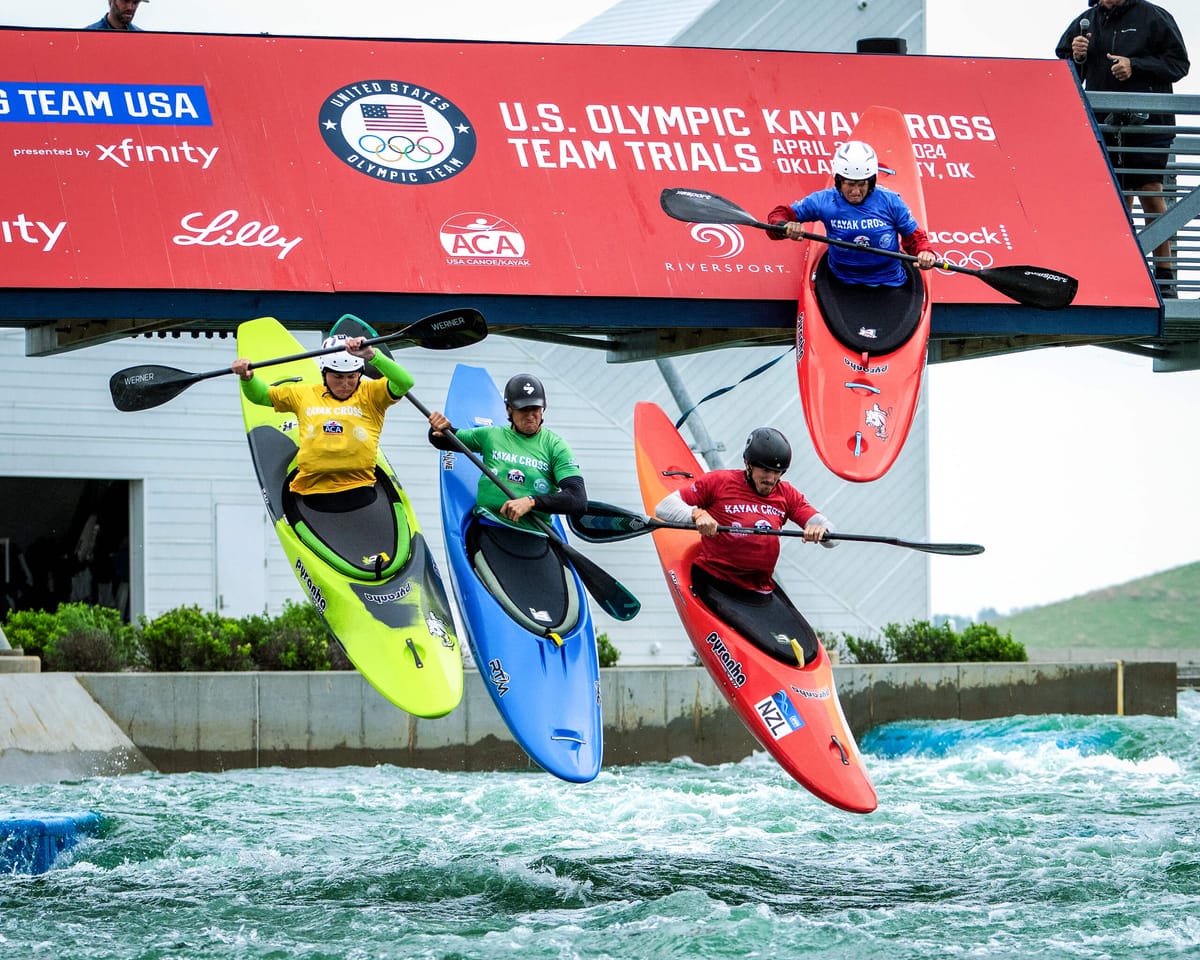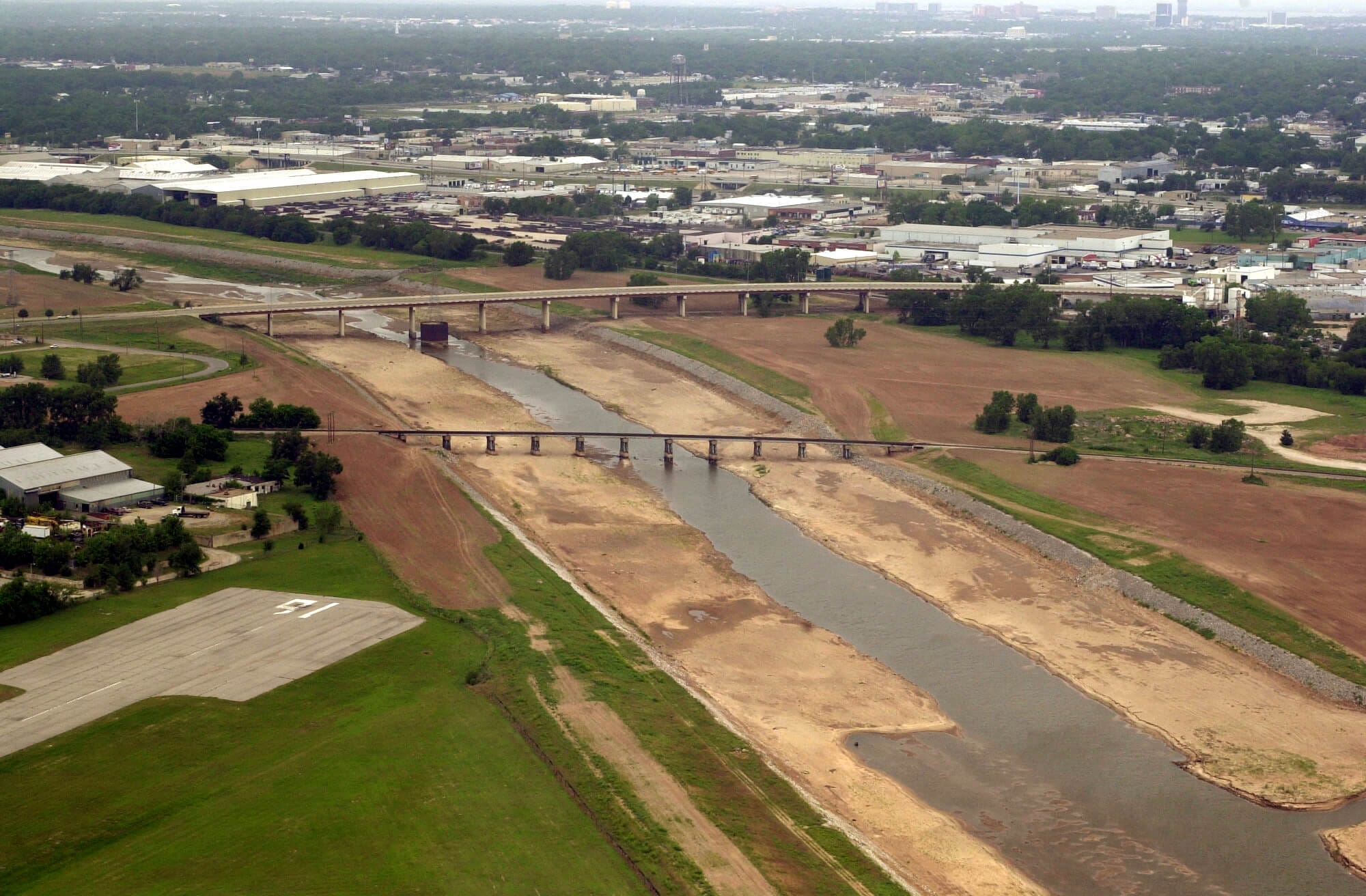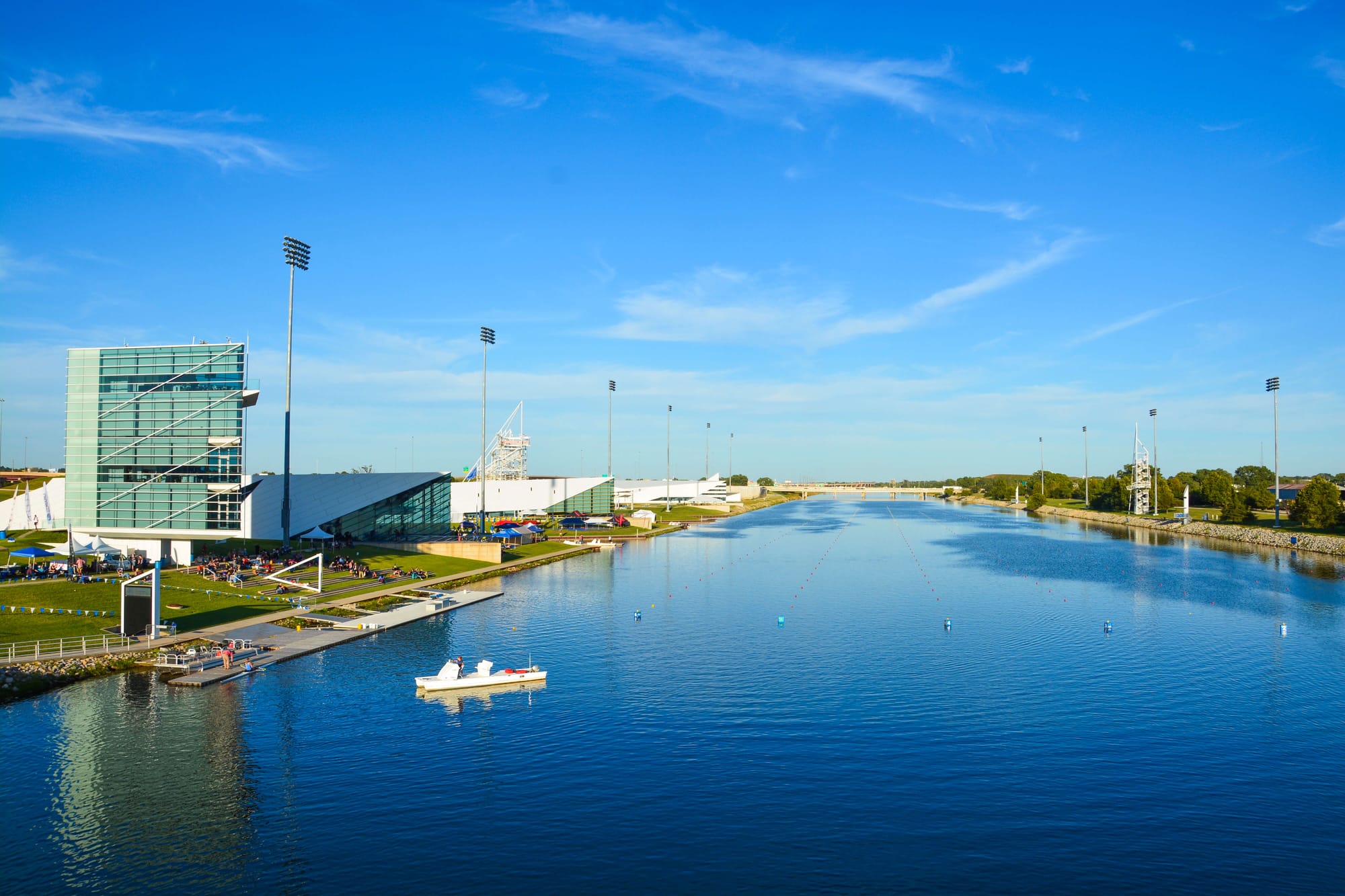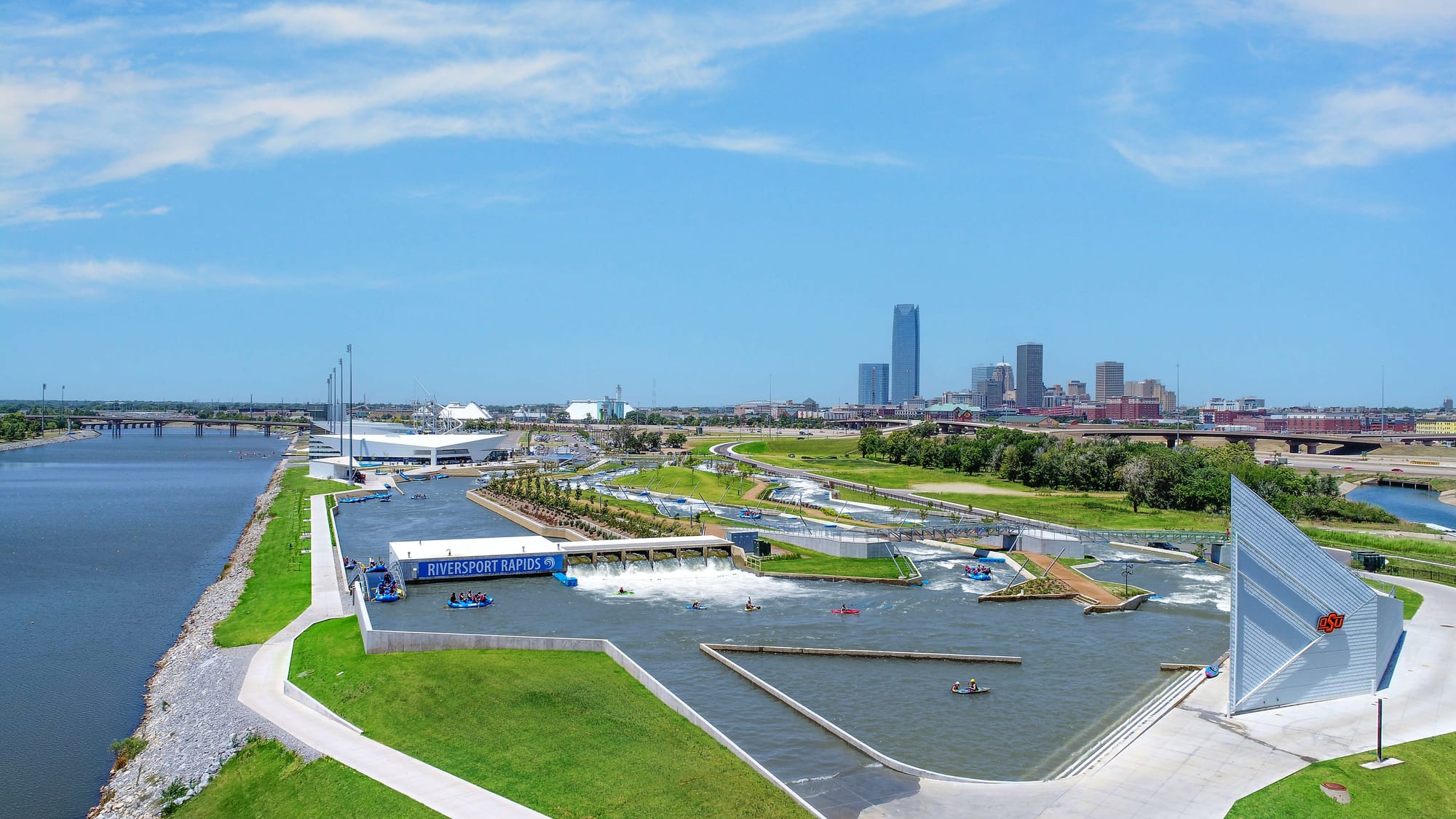
On April 26 and 27, American Olympic team hopefuls flew in from around the country to participate in the U.S. team trials for Canoe/Kayak Slalom and Kayak Cross for the 2024 Paris Olympic and Paralympic Games — which took place at RIVERSPORT in Oklahoma City.
Amid all the international attention, it’s fairly easy to forget how, a little over 20 years ago, the former North Canadian River was largely just dry sandbanks in a quiet area of downtown Oklahoma City. It took a series of fortunate and seemingly serendipitous events (along with blood, sweat and tears) to make the Boathouse District an international paddling destination.
“Each one of these milestone events led us to the next step, which led us to where we are today,” says Mike Knopp, executive director of the RIVERSPORT Foundation. “We just hosted our fourth Olympic trials and we’re going to have a world championship here in 2026.”

The River You Had to Mow
While numerous long-time Oklahoma City residents remember the river’s derelict days, there aren’t many remaining who directly remember its former heyday just over a century ago.
According to The Oklahoman, the river was popular in the early 20th century, offering attractions like the Delmar Gardens amusement park, trails, baseball fields, even a zoo. However, the frequent flooding along the river’s banks largely killed those development efforts.
After OKC officials used bond money to purchase land on either side of the river for flood control, the Army Corps of Engineers straightened the river in the 1950s to aid with water management efforts. The effort was a success … and removed most of the water from the river. The trails, industries and recreational development dried up like the river bank and sat largely vacant for decades. As Knopp puts it, “the joke is we mowed it — the river that we mowed two to three times a year.”
Fast-forward to the 1990s. The original MAPS project was underway, and taxpayer money was earmarked for installing well-water dams, returning outdoor trails and landscaping around the river.
When Knopp, then an assistant district attorney for Oklahoma County, heard of MAPS, his interest was piqued. A former collegiate rower, Knopp would go on jogs at the riverbank and consider its potential as a rowing destination.
“[The river] was totally straight in this section that happened to be over 2,000 meters long,” says Knopp, highlighting the standard distance of most rowing races. “And as a guy that knew the sport, I knew this could be really something special.”
Knopp quickly got involved in the Riverfront Redevelopment Authority meetings, working with Ray Ackerman, who was a major believer in the river. Knopp convinced Ackerman that the river really needed a boathouse and that the community needed rowing programming.
“The story I always like to share is that it rained just enough the night before [the MAPS] groundbreaking that I was able to get to friends of mine and some new rowers, and we put boats on the river,” recalls Knopp.
“It was like a light went on for people to see: This is what an active riverfront would look like.”

Building the Foundation
The next few years were a whirlwind of activity for Knopp and his growing paddlesports community. While he and volunteers brought collegiate rowing to OCU in 2000, it wasn’t until 2004 that former Chesapeake Energy CEO Aubrey McClendon gave the seed money for the Chesapeake Boathouse to be built on the newly renamed Oklahoma River.
The first annual OCU Head of the Oklahoma Regatta was also that year, attracting over 15,000 attendees and bringing national attention from rowers and water sport enthusiasts. Knopp jumped ship from his life as general counsel for the FAA to founding the Oklahoma City Boathouse Foundation (now known as the RIVERSPORT Foundation) to help manage the boathouse and rowing programming as its executive director.
But it wasn’t until 2006 that Knopp and the Oklahoma City Boathouse Foundation team got international and Olympic attention by “basically inventing night racing” after hosting the first-ever lighted rowing regatta with OGE Night Sprints. The river was illuminated by installing temporary stadium lights at the river, allowing racing to happen at night — which was unheard-of at the time.
With the world’s eye on Oklahoma City, the U.S. Olympic and Paralympic Committee selected the Oklahoma River and the soon-to-be-called Boathouse District as the site for the 2008 U.S. Olympic Trials in Canoe/Kayak. RIVERSPORT earned an official designation as a U.S. Olympic and Paralympic training site in 2009, one of nine in the U.S. and the only river to receive the distinction.

An International Stage
The Head of the Oklahoma, the race that started it all, celebrates its 20th anniversary Oct. 5-6. And this is a milestone year for more reasons than just this.
“It’s taken 20 years, but now the fact that US Rowing decided to combine their two big summer national championship events into one and host it in one location in Oklahoma City, because they want to show the whole country Oklahoma City, is a pretty big statement,” says Knopp.
And these world-class events garner the attention of not just athletes and sporting enthusiasts, but trade groups and industry leaders as well. The Paddlesports Trade Coalition is hosting its first annual industry trade show and meeting in Oklahoma Sept. 3-6.
“OKC is a very welcoming place; never heard a bad word,” says Jeff Turner, executive director of the Paddlesports Trade Coalition. Turner explained that the PTC is hoping to make Oklahoma City the home of its annual meeting for the next five years and that he “hoped that OKC continues its commitment to paddling.”
That wish seems all but certain, as 2025 brings the Canoe Slalom and Sprint Super Cups to OKC, and in 2026, RIVERSPORT plays host to the ICF’s Canoe Slalom World Championships. The next few years seem bright with opportunities for RIVERSPORT.
“I mean, when you’re on the rapids, and you’re getting ready to go down the channel, you’re looking at our downtown skyline,” says Knopp. “It’s just such a unique site for people that are involved recreationally and in paddlesports.” •
Spectators wanting to cheer on the athletes who qualified for the U.S. Teams at RIVERSPORT can watch the Paris Olympics starting July 27. To see upcoming RIVERSPORT events or plan an excursion, visit riversportokc.org.

